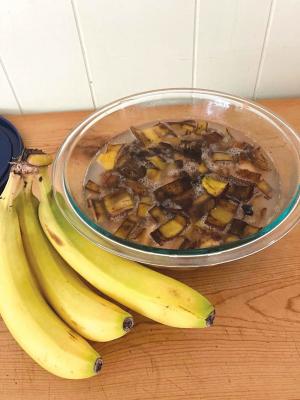Banana Peel Fertilizer Nourishes Plants
 ✖  |
If you love bananas, consider keeping the peels to soak for a nutrient-rich plant fertilizer. It’s flush with potassium, calcium, phosphorus, and magnesium, strengthening stems and roots. Best of all, this fertilizer is essentially free, assuming you’d eat the bananas anyway.
Banana peel water, or banana tea, is made by steeping banana peels in a jar or bucket for several weeks. The soaking process helps the peels break down, releasing nutrients into the water, which is applied directly to plants.
While banana water is mild enough for use on any plant, the extra potassium levels might be especially beneficial for those that fruit and flower. It may help prevent blossom end rot in tomatoes, a condition where the bottom of the fruit turns brown. However, banana water doesn’t provide the fully balanced nutrient profile that plants need. It works well for supplementation but shouldn’t be your primary fertilizer. Over-reliance on it might lead to nutrient deficiencies like yellowing leaves or stunted growth.
Another essential consideration is pesticide contamination. Conventionally grown bananas may have residues on their skin, which could be transferred to your liquid fertilizer. Washing the peels before soaking them can eliminate most of these residues. For extra safety, stick with certified organic.
To make banana water, start by saving your peels. Chop them into 1-in. squares covered 2/3 of the way with water. You can also pulverize them in a blender to speed up the decomposition. Keep adding peels and water into a large container until you run out of space—ensuring the lid stays in place to prevent contamination and mold formation. Store it in a cool, dark place so the peels can continue to steep for another 2 weeks. The water is done once the peels turn black and the water is dark. A slight fermenting odor is normal. At this point, you can strain out the solids and pour the liquid into a watering can for direct use on plants. Any remaining banana peel remnants can go into the compost.
One study found that boiling the peels boosts potassium levels in water. Steep the peels for a few days, then add them to a saucepan and boil for up to 45 min. The mixture should be cooled and diluted before applying.
Use banana water once per week as part of your regular watering schedule. It’s ideal for houseplants and outdoor beds alike. Pour water on the soil line to avoid soaking plant leaves and mold growth.
Banana peel water is easy to make, costs virtually nothing, and encourages the daily consumption of this nutritious fruit.

Click here to download page story appeared in.
Click here to read entire issue
Banana Peel Fertilizer Nourishes Plants FARM HOME Miscellaneous If you love bananas consider keeping the peels to soak for a nutrient-rich plant fertilizer It’s flush with potassium calcium phosphorus and magnesium strengthening stems and roots Best of all this fertilizer is essentially free assuming you’d eat the bananas anyway Banana peel water or banana tea is made by steeping banana peels in a jar or bucket for several weeks The soaking process helps the peels break down releasing nutrients into the water which is applied directly to plants While banana water is mild enough for use on any plant the extra potassium levels might be especially beneficial for those that fruit and flower It may help prevent blossom end rot in tomatoes a condition where the bottom of the fruit turns brown However banana water doesn’t provide the fully balanced nutrient profile that plants need It works well for supplementation but shouldn’t be your primary fertilizer Over-reliance on it might lead to nutrient deficiencies like yellowing leaves or stunted growth Another essential consideration is pesticide contamination Conventionally grown bananas may have residues on their skin which could be transferred to your liquid fertilizer Washing the peels before soaking them can eliminate most of these residues For extra safety stick with certified organic To make banana water start by saving your peels Chop them into 1-in squares covered 2/3 of the way with water You can also pulverize them in a blender to speed up the decomposition Keep adding peels and water into a large container until you run out of space—ensuring the lid stays in place to prevent contamination and mold formation Store it in a cool dark place so the peels can continue to steep for another 2 weeks The water is done once the peels turn black and the water is dark A slight fermenting odor is normal At this point you can strain out the solids and pour the liquid into a watering can for direct use on plants Any remaining banana peel remnants can go into the compost One study found that boiling the peels boosts potassium levels in water Steep the peels for a few days then add them to a saucepan and boil for up to 45 min The mixture should be cooled and diluted before applying Use banana water once per week as part of your regular watering schedule It’s ideal for houseplants and outdoor beds alike Pour water on the soil line to avoid soaking plant leaves and mold growth Banana peel water is easy to make costs virtually nothing and encourages the daily consumption of this nutritious fruit
To read the rest of this story, download this issue below or click
here to register with your account number.







